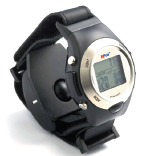A new wrist-mounted device allows more accurate measurement of blood pressure, according to research published recently in the Journal of the American College of Cardiology. The sensor (A-PULSE CASP®, HealthSTATS) … Continue reading Blood pressure readings more accurate with new device

A new wrist-mounted device allows more accurate measurement of blood pressure, according to research published recently in the Journal of the American College of Cardiology.
The sensor (A-PULSE CASP®, HealthSTATS) was used by clinicians to non-invasively record patients’ central aortic systolic pressure (CASP). The measurements were 99% accurate, compared to the pressure measured by inserting a catheter directly into the aorta during a cardiac catheter procedure.
The new technology uses a sensor on the wrist to record the pulse wave and then, using computerised mathematical modelling of the pulse wave, scientists are able to accurately read the pressure close to the heart. Patients who have tested the new device found it easier and more comfortable, as it can be worn like a watch.
Lead author Professor Bryan Williams, University of Leicester, said: “it is not going to replace what we do overnight but it is a big advance. Further work will define whether such measurements are preferred for everybody or whether there is a more defined role in selective cases to better decide who needs treatment and who doesn’t and whether the treatment is working optimally”.
The research was funded by the Department of Health’s National Institute for Health Research (NIHR). The NIHR has invested £3.4 million to establish a Biomedical Research Unit at Glenfield Hospital, Leicester, dedicated to translational research in cardiovascular research, with a further £2.2 million Capital funding from the Department of Health. Professor Williams added: “The support of the NIHR has been invaluable in backing us to take this project from an idea to the bedside”. The University worked closely with the Singapore-based medical device company HealthSTATS International to develop the device.

Cardiovascular disease gender gap highlighted
Complacency over cardiovascular disease (CVD) in women was the focus of the European Society of Cardiology’s (ESC) recent ‘Women@Heart’ contest, which called on its 53 member nations to submit ideas for public awareness campaigns.
The Latvian Society of Cardiology won with its proposal for a campaign, ‘It’s a Red Alert’, targeting both medical professionals and the general public with activities timed around International Women’s Day and Mother’s Day.
Material from the winning campaigns will be available for re-use by other national societies.
Professor Marco Stramba-Badiale, former chair of the ESC’s ‘Cardiovascular Diseases in Women’ task force, said: “The belief that somehow women are protected from cardiovascular disease is completely wrong…. statistics from the World Health Organisation in 2008 actually show that 55% of female deaths in the EU are due to heart attack, stroke and other conditions compared to just 43% of males”.
